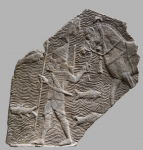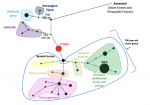Zuzan
Well-Known Member
Makes we wonder about the Roman cavalry and what size their horses were... I believe their cavalry came from the Caucasus Mts and their descendents are the Kabardins which are circa 16hh I think.
They were 13 - 14 h.Makes we wonder about the Roman cavalry and what size their horses were... I believe their cavalry came from the Caucasus Mts and their descendents are the Kabardins which are circa 16hh I think.
Would have thought Kabardins would be on average 14 handers. Can't imagine a mountain breed kept in tough conditions being much bigger than that.I believe their cavalry came from the Caucasus Mts and their descendents are the Kabardins which are circa 16hh I think.
Over 400 years or so they would have been changing (sources and type) and you'd have had a massive Iranian influence on/from the Caucasus in between the Romans and now anyway. There's horse-breeding in the region of modern Iran for the Assyrian army in the 8th century BC... There are always going to be massive bottlenecks and big reorientations around breeding from new and different stallions in every breed's evolution I suppose.Makes we wonder about the Roman cavalry and what size their horses were... I believe their cavalry came from the Caucasus Mts and their descendents are the Kabardins which are circa 16hh I think.

Yep, a broken up bit from 19th century excavations, I forgot the link:Great pic .. what's it from ? Assyrian freeze ?
I always thought if you shot bucket loads of carrots behind enemy lines then pointed a load of draft horses in that direction you'd send the enemy flying in short order
Makes we wonder about the Roman cavalry and what size their horses were... I believe their cavalry came from the Caucasus Mts and their descendents are the Kabardins which are circa 16hh I think.
loving the opportunity to dig further: cavalry units from Spain and beyond the Danube in Lancashire - whether they shipped all or only few horses, someone better informed than me would have to say: http://ribchesterromanmuseum.org/history.htmThe year they did Roman cavalry on Hadrian's wall, which we visited twice, it seemed the men and horses posted there came from Germany?
???I like their onesies.
Were any of the current native Irish breeds around back then, I wonder?Icelandic horses are mostly descended from horses taken there from Ireland. Vikings didn't bring horses with them when they went a-raiding, they preferred to 'acquire' them from the locals, and the Vikings that raided Britain, Ireland and Normandy mostly came from Norway and Denmark.
No just in general, when Arab blood was likely to be used in breeding European horses for instance.
There's presumably a difference between "possible" and "evidenced" - so NW Europe and Syria/Mesopotamia are already linked by sea and organisationally/politically under the Roman empire & you have army detachments moving frequently between one frontier and another. And that's a few hundred years worth of interaction. Plus Vikings sailing to Byzantium. Where do you stop really? But most mentions seem to be of 7th to 8th century & Arab conquest.
Anyway this article does propose the Norman period as a potential link to Britain:
"The changes observed during the Norman period could in part reflect an influx of Arabian blood into Western European horse stock, which is known from Iberia from the 8th century AD (Hyland, 1994). During this period, the Islamic Conquest in Spain provided Europe with access to novel horse lineages, written sources mention that the Normans were gifted horses of Spanish, French and Moorish origins (Fages et al., 2019; Kelekna, 2009) something also reflected in ancient genomics (Fages et al., 2019; Kelekna, 2009). It is possible that these more gracile Norman horses of mixed lineage were perfectly designed for Norman cavalry tactics (Davis, 1987), which were different from the ‘heavy’ cavalry tactics of later periods." (nb haven't looked up the references).

It does me too, but you have to remember that men are bigger now as well.It always spoils it a little for me watching historical films when the characters are seen riding huge modern breeds of horses. Big modern sports type friesians are particularly ubiquitous.
Yes, and they're all speaking English too, tut tut.It always spoils it a little for me watching historical films when the characters are seen riding huge modern breeds of horses. Big modern sports type friesians are particularly ubiquitous.
Ha ha! Yes, probably. Judging by skeletal remains, extant horse furniture and artistic representation the horses used were pony-sized, muscular Iberian types. The horses used in Britain at the time of Hadrian's Wall and later may well have been sourced locally, possibly Highland garron type.Also there would be a public outcry if they had them on ponies as well!
Adding to this: genetic evidence shows that Icelandics, like Shetlands and Fjords, are pretty far removed from Spanish/Arabian blood. They're closer to Przewalski's horses and (I presume) Mongolian ponies. The below image is from Lucy Allen and Wallner et al (2017)'s works.
View attachment 85644
Then Prystupa (2011) found that: 1) Icelandics are closer related to Mongolian ponies than Norwegian Fjords, 2) the rare E haplogroup (only 3% of the world's equine population have it) was the most common haplogroup in the Eriskay, Dales, and Kerry Bog, and also quite common in the Shetland, Icelandic and Fjord (35%, 8%, and 8% respectively), 3) today's E haplogroup dates back as far as the Bronze age in Siberia.
You can find these studies on the Eriskay Pony Society website - I very much recommend a read.
The Turkish influence is obvious through the Byerly Turk (1st sire in the TB line), although his line is less expressed than the later stallions now.These are fascinating case studies. The genomic data seems to be generating slightly newer maps every couple of years (Turkoman input in Thoroughbred creation now way more emphasised?) but in modern populations always dependent on what survives inbreeding and bottlenecks. The big Eurasian states probably always so influential in shaping riding horses across the continent, as suggested by this piece (but I've read others stating that there's a big concentration of sires contributing to modern lines c.1400-1500). Will be so interesting to see how it develops. https://www.nature.com/articles/d41586-021-02858-z
Ah really? I was just popping back in to add this link, though it's not the only read on the Turkoman breeding in TB foundations, but Darley Arabian also suggested to be Turkoman:The Turkish influence is obvious through the Byerly Turk (1st sire in the TB line), although his line is less expressed than the later stallions now.
yes, this change of policy/type is discussed in the research paper, especially re increasing robustness of the hind limbs.And there was the 'Horse Act' of the 1530's implemented by Henry VIII. The export of all horses was forbidden, and horses less than a certain height (15hh?) were forbidden from grazing on common land in a bid to breed bigger horses. Henry was desperately trying to improve the size of horses in a bid to breed the ultimate war horse. Any horses under a certain height were to be grazed in an enclosed area or killed so they were unable to breed. Henrys daughter - QE1 - also went to great lengths to improve the country's horse stocks.
Apparently Henry was an unusually big fella - if you've seen his armour at the tower of London, you'll see, so he must have had a pretty big horse. Perhaps some sort of 'prototype' european heavy draught as I don't think Shire horses had been developed in Tudor times?
The "less than" height was 13h. There were no Shire/Clydesdale type tall heavy horses at all before the 18c, although there were heavier "punch" type horses used for ploughing and heavy draught work. Some of the horse varieties were: the "grete" horses, coursers, rouncies, stotts, jacas, and so on, all of different types and utility. Henry VIII was 6' and rode mostly Spanish or Neopolitan horses (he didn't get really fat until his jousting days were over BTW).And there was the 'Horse Act' of the 1530's implemented by Henry VIII. The export of all horses was forbidden, and horses less than a certain height (15hh?) were forbidden from grazing on common land in a bid to breed bigger horses. Henry was desperately trying to improve the size of horses in a bid to breed the ultimate war horse. Any horses under a certain height were to be grazed in an enclosed area or killed so they were unable to breed. Henrys daughter - QE1 - also went to great lengths to improve the country's horse stocks.
Apparently Henry was an unusually big fella - if you've seen his armour at the tower of London, you'll see, so he must have had a pretty big horse. Perhaps some sort of 'prototype' european heavy draught as I don't think Shire horses had been developed in Tudor times?